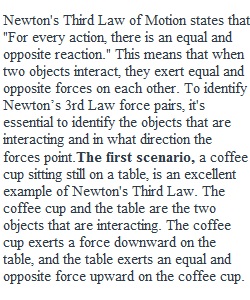


Q Identifying Newton’s 3rd Law Pairs For each of the following situations identify identify the Newton’s 3rd Law force pairs. Which objects are interacting and in what direction do the respective forces point? Discuss both their directions and magnitudes! 1. A coffee cup sitting still on a table. the cup the table 2. Two boxes sitting on top of each other. the bottom box the top box 3. A person falling toward earth. the person the earth Rubric Modeling Modeling Criteria Ratings Pts This criterion is linked to a Learning OutcomeAccuracy All the ideas used in the diagram and/or narrative correspond to ideas established by the class thus far. (No ideas are used that have not been previously established and agreed on.) 5 pts This criterion is linked to a Learning OutcomeCompleteness All the established ideas and assumptions necessary to explain the event are included in the diagram and/or narrative. (No relevant ideas are missing.) 5 pts This criterion is linked to a Learning OutcomeClarity and Logical Reasoning The presentation is well done so that it flows logically and is easy to follow. It also explicitly connects the relevant ideas to the event being explained. 5 pts Total Points: 15 PreviousNext
View Related Questions